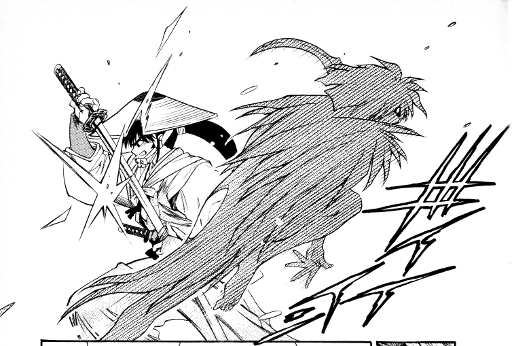 (『MISTER ジパング』椎名高志)
(『MISTER ジパング』椎名高志) (『幻蔵人形鬼話』高田裕三)
(『幻蔵人形鬼話』高田裕三)「鯉口を切る」
"Koiguchi wo kiru"
刀を鞘から抜く前に、侍は左手の親指で鍔を押して刀を少し抜いておきます。
Before pulling out the sword from the sheath, the samurai pushes the TSUBA with his left thumb and pulls out the sword a little.
これを、「鯉口を切る」と言います。
This is called “Koiguchi wo kiru”.
 (『Beast of east』山田章博)
(『Beast of east』山田章博)「抜刀」
"Battou"
この「すらっ」は、鞘と刀身が擦れた音かもしれません。
This "Sura" may be the sound of the sheath and blade rubbing.
 (『十兵衛ちゃん』むっちりむうにぃ)
(『十兵衛ちゃん』むっちりむうにぃ)「構え」
"Kamae"
実際の刀がこのような音を立てるかどうか分かりませんが、時代劇では侍が刀を構えるとき「チャッ」や「チャキッ」という音がします。
I don't know if the actual sword makes such a sound, but in historical drama, when the samurai holds the sword, it makes a "cha" or "chaki" sound.
 (『MISTER ジパング』椎名高志)
(『MISTER ジパング』椎名高志)構造的に音が鳴らない刀でも、マンガの中では構えたことを表すために「チャッ」というオノマトペが使われることがあります。
Even if the sword does not sound structurally, the onomatopoeia "cha" is sometimes used in MANGA to indicate that it is ready.
 (『Beast of east』山田章博)
(『Beast of east』山田章博) (『幻蔵人形鬼話』高田裕三)
(『幻蔵人形鬼話』高田裕三)「受け」
"Uke"
刀と刀が当るときの音は、たいてい「ギィン」と表現されます。
The sound of a sword hitting the sword is often described as "giin."
 (『MISTER ジパング』椎名高志)
(『MISTER ジパング』椎名高志)「鍔迫り合い」
"Tsubazeriai"
刀と刀で押し合うことを「鍔迫り合い」と言います。
Pushing each other with a sword is called "Tsubazeriai".
 (『Beast of east』山田章博)
(『Beast of east』山田章博)「納刀」
"Noutou"
この例では、侍の左手の親指が鍔を押していないので、この侍は刀を抜こうとしているのではありません。刀を鞘に戻したのです。
In this example, the samurai's left thumb is not pushing the TSUBA, so the samurai is not trying to pull the sword. He returned the sword to the sheath.